Vortex-induced vibrations of stepped cylinders with varied spanwise arrangements and diameter ratios
IF 5.5
2区 工程技术
Q1 ENGINEERING, CIVIL
引用次数: 0
Abstract
Vortex-induced vibration (VIV) presents a significant challenge in the design of offshore risers and pipeline systems. Compared to bare uniform risers, the attachment of large-diameter buoyancy modules significantly modifies hydrodynamic characteristics and, consequently affects the fatigue damage of the risers. To improve the understanding and optimization of system VIV, this study experimentally investigates the hydrodynamics and response mechanisms of stepped cylinders under both concentrated and staggered buoyancy module configurations with different diameter ratios (D/d = 1.25, 1.5, 2, D: buoyancy module/large cylinder diameter; d: bare pipe segment/small cylinder diameter) in uniform flow. The results show that stepped cylinder in concentrated configurations exhibits a distinct "dual lock-in" phenomenon, where the frequency in the second lock-in region is notably higher than in the first region. At small and intermediate diameter ratios (D/d = 1.25 and 1.5), the distinct vibration response branches are respectively dominated by the small and large cylinder segments. However, for increasing to the large diameter ratio condition (D/d = 2), the dominance of the large cylinder segment becomes more pronounced. For staggered configurations, the dynamic behavior diverges with diameter ratios: systems with D/d = 1.25, 1.5 exhibit single lock-in characteristics resembling low-mass-damping uniform cylinders, whereas a dual lock-in response emerges at D/d = 2. During the transition between two lock-in regions, the stepped cylinder exhibits shift in vibration frequency and wake pattern, causing a phase jump between the lift force and structural response; this discontinuity alters the effective added mass coefficient, leading to dual lock-in. The mechanism governing VIV responses lies in the dynamic competition between large and small cylinder segments. This competition intensifies wake interactions and amplifies nonlinearity in both hydrodynamic forces and structural vibrations.
不同展向和径比阶梯圆柱体的涡激振动
涡激振动(VIV)是海上立管和管道系统设计中的一个重大挑战。与裸露的均匀立管相比,大直径浮力模块的附着显著改变了立管的水动力特性,从而影响了立管的疲劳损伤。为了更好地理解和优化系统涡激振动,本研究通过实验研究了不同直径比(D/ D = 1.25、1.5、2,D:浮力模块/大缸径;D:裸管段/小圆筒直径)均匀流动。结果表明:阶梯圆柱在集中构型下表现出明显的“双锁”现象,第二锁区的频率明显高于第一个锁区的频率;在小、中径比(D/ D = 1.25和1.5)下,不同的振动响应分支分别以小、大圆柱体段为主。然而,随着直径比增大(D/ D = 2),大圆柱段的优势更加明显。对于交错配置,动态行为随直径比的变化而变化:当D/ D = 1.25、1.5时,系统表现出类似于低质量阻尼均匀圆柱体的单锁锁特性,而当D/ D = 2时,系统表现出双锁锁响应。在两个锁止区之间的过渡过程中,阶梯式气缸的振动频率和尾迹模式发生了变化,导致升力和结构响应之间发生了相位跃变;这种不连续性改变了有效的附加质量系数,导致双重锁紧。控制涡激振动响应的机制在于大、小圆柱段之间的动态竞争。这种竞争加剧了尾流相互作用,放大了水动力和结构振动的非线性。
本文章由计算机程序翻译,如有差异,请以英文原文为准。
求助全文
约1分钟内获得全文
求助全文
来源期刊

Ocean Engineering
工程技术-工程:大洋
CiteScore
7.30
自引率
34.00%
发文量
2379
审稿时长
8.1 months
期刊介绍:
Ocean Engineering provides a medium for the publication of original research and development work in the field of ocean engineering. Ocean Engineering seeks papers in the following topics.
 求助内容:
求助内容: 应助结果提醒方式:
应助结果提醒方式:


